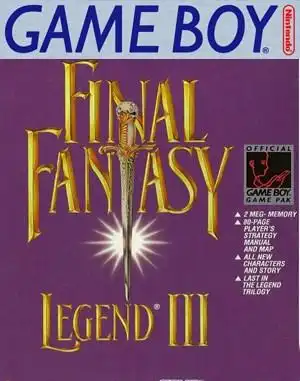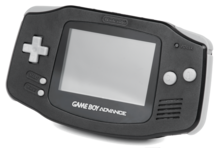Stepping back into the world of Final Fantasy Legend III on the original Game Boy is like opening a dusty photo album from a simpler time. For many of us, this quirky RPG was a staple of long car rides or late-night gaming sessions under the covers, flashlight in hand. It might have had "Final Fantasy" in the title here in the West, but anyone who played it knew it marched to the beat of a different drum – the drum of the SaGa series, specifically known in Japan as SaGa 3: Jikuu no Hasha (Champions of Time and Space).
Released by Square in 1991 (Japan) and 1993 (North America), Final Fantasy Legend III wrapped up the Game Boy trilogy that introduced many players to non-traditional RPG mechanics. While its predecessors were wild and experimental, FFL3 felt slightly more conventional in structure, yet still retained plenty of the unique SaGa DNA that set it apart from the mainline Final Fantasy games.
The Time-Traveling Adventure Begins
The story kicks off with a classic sci-fi setup: a massive, water-spewing monster called the Pureland is threatening to flood the world. To stop it, a group of young heroes must journey through time using a special ship called the Talon. Their quest takes them to the distant past, the far future, and various points in between, meeting different civilizations and gathering allies and powers needed to confront the Pureland's source.
This time-travel mechanic wasn't just a plot device; it was woven into the gameplay, allowing you to revisit locations in different eras to solve puzzles or find new paths. It added a layer of complexity and discovery that felt fresh for a handheld RPG at the time.
More SaGa Than Fantasy? Understanding the Mechanics
While it bore the Final Fantasy nameplate in the West, Final Fantasy Legend III is firmly rooted in the SaGa design philosophy, particularly when it comes to character progression. Forget traditional leveling up where you just gain stats and learn spells. FFL3, like its siblings, had its own unique system.
Character Evolution
Your party members aren't static. They can change!
- Humans: Gain stats randomly after battles.
- Mutants: Stats and abilities increase randomly, and they can learn new magic.
- Creatures: Can transform by eating 'Meat' dropped by monster enemies, gaining their stats and abilities.
- Robots: Can transform by equipping 'Parts' dropped by mechanical enemies, gaining their stats and abilities.
This meant you could strategically turn a Human into a powerful Monster, or a Mutant into a sturdy Robot, by finding the right drops. It was a wild, sometimes unpredictable, but always interesting way to build your team.
The Stat System & Growth
Instead of experience points leading to levels, stats would randomly increase after battles. You never quite knew which stat would go up, adding a layer of randomness that defined the early SaGa games. Weapons also had limited uses, encouraging you to manage resources or find/buy replacements.
Time Travel Mechanics
The Talon wasn't just for show. As you progressed, you'd upgrade its capabilities, allowing you to reach more distant points in time. This often involved finding specific parts or solving puzzles in one era to access another, tying the narrative and exploration together neatly.
Memories of the Mystic Quest
Playing Final Fantasy Legend III today brings back a rush of nostalgia. The monochrome graphics, while simple, were expressive for the Game Boy hardware. The chiptune soundtrack, composed by Ryoji Cope and Nobuo Uematsu, featured memorable tunes that perfectly captured the adventurous and sometimes melancholic atmosphere of the game. Remember the theme for the future world or the battle music? Pure Game Boy magic.
The gameplay loop of exploring new areas, battling unique enemies (and hoping for that crucial Meat or Part drop!), solving time-based puzzles, and uncovering the next piece of the story was incredibly compelling on the go. It was a substantial adventure packed into a tiny cartridge.
Why It's Still Worth Playing Today
Even with advancements in RPGs, Final Fantasy Legend III holds a special place. Its unique character progression, time-travel narrative, and charming presentation make it stand out. If you're a fan of retro RPGs, the SaGa series, or just curious about the roots of handheld JRPGs, it's absolutely worth revisiting.
You can experience it today through various means, whether it's digging out an old Game Boy and cartridge, exploring emulation options (like those found on Archive.org for preservation purposes), or potentially finding it on modern collections or digital stores if Square Enix decides to re-release this classic gem.
Final Thoughts on a Legend
Final Fantasy Legend III might not be as universally known as its mainline cousins, but for a generation of Game Boy owners, it was an epic journey through time and space. Its blend of traditional RPG elements with unique SaGa mechanics created a memorable experience that still resonates with retro gamers today. It's a testament to the kind of ambitious, unconventional ideas that flourished on handhelds back in the day.
Frequently Asked Questions
Is Final Fantasy Legend III a real Final Fantasy game?
No, despite the Western title, it's actually part of the SaGa series, specifically SaGa 3 in Japan. It shares some thematic elements with Final Fantasy but has distinct gameplay mechanics.
How do characters level up in FFL3?
Characters don't gain traditional levels. Stats increase randomly after battles. Humans and Mutants gain stats and abilities, while Creatures and Robots can transform and gain stats/abilities by consuming Meat or Parts dropped by enemies.
Can I play Final Fantasy Legend III on modern consoles?
As of now, Final Fantasy Legend III (SaGa 3) is available as part of the "Collection of SaGa Final Fantasy Legend" which is available on Nintendo Switch, PC (Steam), and mobile devices. This is the most accessible modern way to play it legally.
Is the game difficult?
Like other early SaGa games, FFL3 can be challenging due to the random nature of stat growth and enemy drops. Strategic use of character transformations and managing weapon uses is key.


